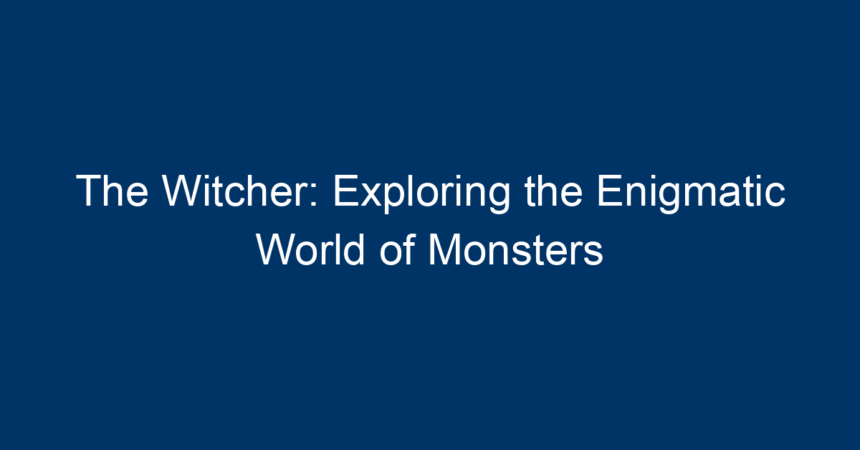In the realm of fantasy literature and gaming, few franchises capture the imagination quite like The Witcher. Since the release of Andrzej Sapkowski’s original book series in the 1980s, this captivating universe has expanded into video games, television series, and comic books, all while maintaining a richly layered mythology that draws fans from all over the world. At the heart of The Witcher lies an intriguing gallery of monsters, each with its unique lore, abilities, and moral implications. In this article, we will delve into the complex world of monsters in The Witcher, examining their origins, significance, and the ethical dilemmas they present to characters like Geralt of Rivia.
The Origins of Monsters in The Witcher
Folklore and Mythology
The monsters in The Witcher are heavily influenced by European folklore and mythology. From the fearsome Leshen to the seductive Sirens, each creature often embodies deeper meanings that reflect human anxieties and societal norms. For example, the Striga, a creature cursed to become a woman with monstrous traits, serves as a metaphor for unresolved trauma and societal rejection. Sapkowski’s deep understanding of folklore allows readers and players to connect with these monsters on an emotional level, enriching the narrative experience.
The Influence of Slavic Myth
While The Witcher draws from various cultural mythologies, Slavic folklore is particularly evident. Many of the creatures encountered in Geralt’s journeys originate from Slavic myth, which often includes tales about nature spirits, vengeful ghosts, and monstrous beings that embody humanity’s darker aspects. This grounding in real-world folklore not only makes the monsters more relatable but also invites players and readers to explore the complexities of human nature through fantastical lenses.
Iconic Monsters of The Witcher Universe
1. Geralt of Rivia: The Witcher
No discussion of monsters in The Witcher would be complete without mentioning Geralt himself. As a witcher, Geralt is a trained monster hunter equipped with powerful potions and combat skills. However, Geralt often grapples with the moral complexity of his role. The saying “The only monster here is a man” resonates deeply in his adventures, showcasing how monsters can often be more human than humans themselves.
2. The Leshen
The Leshen is a protector of the forest, deeply connected to nature. This towering creature resembles a stag with a tree-like body, symbolizing the wildness of natural forces. Encountering a Leshen often prompts players to consider their relationship with nature, emphasizing themes of conservation and the impact of human encroachment on the environment. Yet, when provoked, the Leshen becomes a fierce adversary, illustrating the duality of nature.
3. The Striga
At the heart of tragedy, the Striga is a poignant figure. Cursed during childhood, she transforms into a monstrous being, reflecting the impact of trauma and isolation. Geralt’s quest to lift the curse reveals the monster hidden beneath her fearsome exterior, forcing him to confront not just the creature but the societal failings that led to her plight. This character serves as a reminder that every monster has a story, inviting empathy rather than fear.
4. The Drowner
These aquatic monsters are manifestations of tragic deaths and unresolved grievances, haunting moors and rivers. Drowners not only serve as formidable enemies for Geralt but also to explore themes of grief and loss. Their backstory pushes players to ponder the humanity that lies beneath the surface of all creatures.
The Monster Hunter’s Code: Morality in The Witcher
The Moral Ambiguity of Witchers
One of the most compelling elements of The Witcher is its exploration of moral ambiguity. Geralt’s profession as a monster hunter often places him in ethical dilemmas where he must balance business, justice, and personal morals. Should he slay a monster solely because it poses a threat, or should he explore its backstory and the circumstances that made it a monster?
Choices and Consequences
In the video games, players are frequently presented with choices that affect the narrative and the world around them. These decisions often involve the monsters themselves. For instance, players can choose to kill a creature or seek a peaceful resolution. Each choice has consequences that reflect the intricate web of relationships between humans and monsters, reinforcing the idea that not everything is black and white.
How The Witcher Portrays Humanity’s Darkness
Monsters as Reflections of Human Nature
In The Witcher, monsters often serve as mirrors to humanity’s darker traits—greed, jealousy, fear, and revenge. By wrestling with these beings, Geralt and other characters confront their inner demons. This narrative technique allows for profound character development and enriches the world-building of The Witcher.
The Complexity of Villains
Many characters classified as ‘monsters’ are not solely evil; they are often shaped by their circumstances. Creatures like the Vampires and Crones have rich backstories that offer insights into their motivations, allowing players to grasp the vast grey areas between heroism and villainy. This complexity fosters an environment where players must think critically, questioning their preconceived notions of good and evil.
The Future of Monsters in The Witcher Franchise
Upcoming Adaptations and Expansions
With the success of the recent Netflix adaptation and the anticipated releases of new video games, the world of The Witcher is evolving. Fans can expect fresh interpretations of classic monsters alongside entirely new creatures that may introduce modern audiences to unexplored myths and narratives.
Engaging with New Talents
Collaborations with a diverse array of writers and artists promise to broaden the scope of The Witcher, paving the way for innovative storytelling that reflects a balance of respect for the source material and the need for cultural relevance. This development holds great potential for introducing new monsters while deepening the lore behind those already familiar to fans.
Conclusion: Embracing the Enigma of Monsters
The world of The Witcher offers an intricate tapestry of monsters that captivate and challenge our understanding of humanity. Through their stories, we are invited to confront our fears, prejudices, and moral dilemmas. As players and readers navigate this fantastical realm, they learn that monsters often have tales worth telling—tales that can foster empathy and understanding.
In capturing the essence of ambiguity and complexity, The Witcher encourages us to look beyond the surface, reminding us that the true monsters may often reside within. As The Witcher continues to evolve, one can only hope that it maintains its dedication to exploring not just the supernatural, but the deeply human narratives woven through its enigmatic world of monsters. Engage with this rich landscape, and discover not only the thrill of the hunt but also the profound insights that lie hidden within the shadows.




